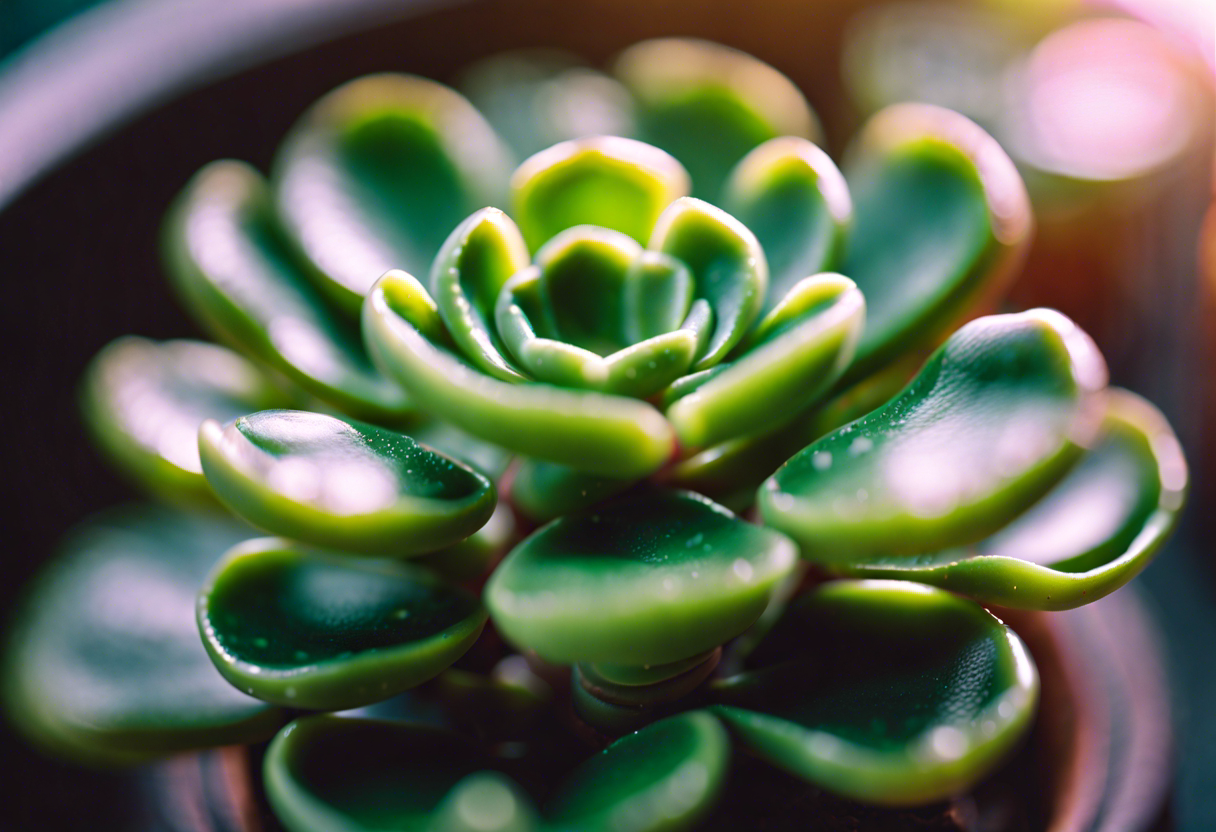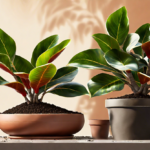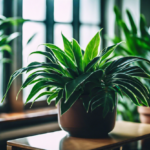Proper Lighting Requirements for Jade Plants
Jade plants, scientifically known as Crassula ovata, are popular houseplants known for their thick, fleshy leaves and their ability to thrive in various conditions. One crucial aspect of jade plant care is providing the proper lighting conditions to ensure its healthy growth and vibrant appearance.
When it comes to lighting, jade plants prefer bright, indirect light. Placing them near a window that receives bright, filtered sunlight is ideal. However, direct sunlight can scorch the leaves and cause damage, so it is important to avoid exposing the plant to intense, direct sunlight for extended periods.
To ensure even growth, it is recommended to rotate the plant every few weeks so that each side receives an equal amount of light. This will prevent the plant from leaning towards the light source and promote symmetrical growth.
If you don’t have access to a well-lit area, artificial grow lights can be a great alternative. LED grow lights are particularly suitable for jade plants due to their low heat emission and energy efficiency. Position the lights approximately 12-18 inches above the plant, providing them with around 12-14 hours of light per day.
During the winter months when daylight is limited, it may be necessary to supplement natural light with artificial lighting to ensure the plant receives an adequate amount of light for proper growth.
It is important to monitor your jade plant closely for signs of inadequate or excessive lighting. If the leaves begin to turn pale green or yellow, it may indicate that the plant is not receiving enough light. On the other hand, if the leaves start to develop brown patches or sunburn marks, it may be an indication of excessive light exposure.
Providing the right amount and quality of light is essential for the health and growth of jade plants. By positioning them in a well-lit area or using artificial grow lights, you can ensure they receive the optimal lighting conditions they need to thrive.
Watering Techniques and Frequency for Jade Plants
Jade plants, also known as Crassula ovata, are succulent plants that are native to South Africa. These beautiful plants are known for their resilient nature and ability to thrive in dry conditions. However, when it comes to watering jade plants, it is essential to strike the right balance to ensure their optimal growth. Here are some watering techniques and frequencies to keep your jade plant healthy.
Testing Soil Moisture
To determine when to water your jade plant, it’s crucial to assess the moisture levels in the soil. Stick your finger about an inch deep into the soil near the plant’s base. If the soil feels dry at this depth, it’s an indication that your plant requires watering. However, if the soil is still moist, hold off on watering for a few more days.
Watering Jade Plants
When watering your jade plant, it’s essential to water thoroughly. This means providing enough water so that it reaches the plant’s entire root system. Water the soil until you see water coming out of the drainage holes at the bottom of the pot. This ensures that the roots receive an adequate amount of water. Avoid frequent light watering sessions, as this can lead to poor root development and make the plant more susceptible to stress.
Drainage is Key
Jade plants are susceptible to root rot if their soil becomes excessively waterlogged. To prevent this, ensure that the pot you use has proper drainage holes to allow excess water to escape. Additionally, using a well-draining soil mix specifically formulated for succulents is vital. This allows the water to pass through the soil easily, preventing it from sitting around the roots.
Frequency of Watering
The frequency of watering your jade plant will depend on various factors such as the climate, humidity levels, and the size of the pot. As a general rule, water your jade plant when the soil feels dry to touch. However, it’s important to note that jade plants prefer to be slightly underwatered rather than overwatered. Overwatering can lead to root rot and other moisture-related issues. Aim to water your jade plant every two to three weeks during the growing season, and reduce the frequency in winter when the plant is dormant.
Extra Tips for Watering
Here are a few additional tips to help you maintain the right watering routine for your jade plant:
-
Avoid misting the leaves of your jade plant, as excess moisture can promote fungal diseases.
-
If you’re unsure whether your jade plant needs watering, it’s better to wait a few days rather than overwatering.
-
During the winter months, when the plant’s growth slows down, reduce the amount of water you give to prevent over-saturation of the soil.
By following these watering techniques and frequencies, you can ensure that your jade plant remains healthy and continues to thrive. Remember, proper watering is just one aspect of jade plant care. Understanding your plant’s lighting, temperature, and fertilization needs are equally crucial for its overall well-being.
Ideal Temperature and Humidity Levels for Jade Plants
When it comes to caring for your Jade Plants (Crassula ovata), providing the ideal temperature and humidity levels is crucial for their overall health and growth. These beautiful succulents thrive in specific conditions that mimic their natural habitats. Here’s a comprehensive guide on how to create the perfect environment for your Jade Plants.
Temperature Requirements:
Jade Plants are native to arid regions, and they prefer warm temperatures. Ideally, they thrive in temperatures between 65°F and 75°F (18°C – 24°C) during the day. However, they can tolerate slightly cooler temperatures down to 50°F (10°C) at night.
It’s important to avoid sudden temperature fluctuations and exposure to extreme cold or heat, as this can stress the plant and affect its growth. Placing your Jade Plant near drafty windows or in direct airflow from air conditioning units or heaters should be avoided.
Humidity Levels:
Jade Plants are adapted to low humidity environments, so they can handle drier conditions. However, they will benefit from moderate humidity levels, particularly during the winter months when indoor heating can cause the air to become excessively dry.
To increase humidity, you can place a tray filled with water near your Jade Plant or use a humidifier in the room. Avoid misting the foliage directly, as this can lead to fungal diseases and rot. Finding a balance between providing enough humidity without causing excess moisture is essential.
Protecting from Cold Conditions:
Jade Plants are susceptible to damage from cold temperatures and frost. If you live in a region with harsh winters, it’s important to take precautions to protect your Jade Plant. Move it away from drafty windows and doors during the winter months, as these can expose it to cold drafts. You may also consider using insulation or frost cloth to shield the plant from freezing temperatures if it’s located outdoors.
Adapting to New Environments:
When introducing your Jade Plant to a new environment or relocating it to a different spot, it’s important to acclimate it gradually. Sudden changes in temperature or humidity can cause stress and lead to leaf drop or other issues. Place it in the new location for a few hours each day, gradually increasing the time over the course of a week or two until it’s acclimated to its new surroundings.
By providing the ideal temperature and humidity levels, you can ensure that your Jade Plant remains healthy and thrives in its environment. Monitor the conditions regularly and make any necessary adjustments to create a comfortable and suitable habitat for your beloved Jade Plant.
Fertilization Needs of Jade Plants
Jade plants (Crassula ovata) are known for their resilience and ability to thrive in various growing conditions. However, to ensure optimal growth and health, it is important to understand their fertilization needs. By providing the right nutrients at the right time, you can help your jade plant reach its full potential.
Jade plants are slow-growing succulents that have adapted to survive in nutrient-poor soil. As such, they do not require frequent fertilization. In fact, over-fertilizing can be detrimental to their overall well-being. It is best to adopt a less-is-more approach when it comes to feeding your jade plant.
During the spring and summer months, when the jade plant is actively growing, you can begin your fertilization routine. Choose a balanced, water-soluble fertilizer with an N-P-K ratio of 10-10-10 or 20-20-20. This means that the fertilizer contains equal parts of nitrogen (N), phosphorus (P), and potassium (K), which are the primary macronutrients necessary for plant growth.
Dilute the fertilizer to half the recommended strength to avoid overfeeding. Too much nitrogen can lead to excessive leaf growth at the expense of the plant’s overall structure. Apply the diluted fertilizer once every 3-4 weeks, moistening the soil thoroughly.
It is crucial to water the jade plant before applying fertilizer to prevent root burn. Dry roots can absorb the concentrated fertilizer, causing damage to the plant. Always follow the instructions provided by the manufacturer and adjust the frequency and strength of fertilization according to your jade plant’s response.
During the fall and winter months, when the jade plant enters a period of dormancy, reduce or altogether suspend fertilization. The plant’s growth slows down during this time, and it requires fewer nutrients. Fertilizing during dormancy can disrupt the natural cycle of the plant and potentially harm its health.
In addition to regular fertilization, it is essential to incorporate organic matter into the soil when repotting your jade plant. This can help improve soil fertility and provide slow-release nutrients over time. Organic matter, such as well-rotted compost or aged manure, can be added to the potting mix to enhance the overall health of the plant.
Monitoring your jade plant’s growth and response to fertilization is crucial. If you notice signs of nutrient deficiency, such as pale or yellowing leaves, consider adjusting your fertilization routine. Conversely, if you observe signs of overfertilization, such as leaf burn or stunted growth, reduce the frequency or strength of fertilizer application.
By understanding the fertilization needs of jade plants and providing them with appropriate care, you can help these beautiful succulents thrive. Remember to always approach fertilization with moderation and attentiveness, allowing your jade plant to grow and flourish naturally.
Common Pests and Diseases Affecting Jade Plants
Jade plants (Crassula ovata) are known for their resilience and ability to withstand a variety of conditions. However, like any other plant, they are not immune to pests and diseases. Understanding common issues that can affect your jade plant is essential to ensuring its health and longevity.
Pests
Jade plants can fall prey to certain pests that can damage their leaves, stems, and even the roots. One of the most common pests that affect jade plants is the mealybug. These small, soft-bodied insects feed on the sap of the plant, which can result in stunted growth and leaf drop. To get rid of mealybugs, you can manually remove them with a cotton swab dipped in rubbing alcohol or use an insecticidal soap.
Another pest that can cause problems for jade plants is the spider mite. These tiny arachnids feed on the plant’s sap and can cause yellowing leaves with webbing. To control spider mites, you can use a strong stream of water to wash them off the plant or apply insecticidal soap or neem oil.
Diseases
Jade plants are generally resistant to diseases. However, overwatering can lead to root rot, which is a common issue for these plants. Root rot occurs when the roots are constantly saturated with water, leading to fungal infections. To prevent root rot, make sure to let the soil dry out between waterings and use well-draining soil.
Another disease that jade plants can encounter is powdery mildew. This fungal infection presents as a white, powdery coating on the leaves and stems. Powdery mildew thrives in humid conditions, so it’s important to maintain proper ventilation around the plant and avoid overhead watering. You can treat powdery mildew with a fungicide specifically designed for this purpose.
Prevention and Maintenance
To keep your jade plant healthy and prevent pest and disease issues, it’s important to maintain proper care practices. Provide your jade plant with adequate light, as insufficient light can weaken the plant, making it more susceptible to pests and diseases. Avoid overwatering by allowing the soil to dry out before watering again.
Regularly inspect your jade plant for any signs of pests or diseases. Early detection can help prevent the problem from spreading and causing severe damage. If you notice any issues, promptly take appropriate action to control the pests or treat the disease.
Jade plants are generally hardy plants but can still be affected by pests and diseases. By understanding and implementing proper care practices, you can ensure a healthy and thriving jade plant that brings beauty to your indoor or outdoor space.
Conclusion
The proper care of Jade Plants (Crassula ovata) is crucial to ensure their health and vitality. Understanding their specific lighting requirements is essential, as they thrive in bright, indirect light. Placing them near a south-facing window or providing artificial grow lights can help meet their lighting needs. Care should be taken to avoid direct sunlight, as it can scorch the leaves.
Watering techniques play a vital role in the care of Jade Plants. These succulents have thick, fleshy leaves that store water, making them drought-tolerant. It is important to allow the soil to dry out between waterings to prevent root rot. When watering, thoroughly saturate the soil and allow any excess water to drain away completely. Overwatering can cause the plant to become waterlogged, leading to root rot and other complications.
Maintaining ideal temperature and humidity levels is essential for the health and well-being of Jade Plants. They prefer moderate temperatures between 65-75°F (18-24°C). However, they can tolerate slightly cooler temperatures during winter months. It is important to avoid exposing them to extreme cold or hot temperatures, as it can cause damage to the leaves and overall health of the plant. As for humidity, Jade Plants are adaptable and can tolerate average household humidity levels without any issues.
Understanding the fertilization needs of Jade Plants is crucial for their growth and development. These plants benefit from a balanced, water-soluble fertilizer that is diluted to half strength. Fertilizing should be done sparingly, about once a month during the spring and summer months. It is recommended to withhold fertilizer during the winter months when the plant is in its dormant phase.
Like any houseplant, Jade Plants are susceptible to certain pests and diseases. Common pests that can affect Jade Plants include mealybugs, scale insects, and spider mites. Regularly inspecting the plant for any signs of infestation is vital in catching and treating these pests early. Additionally, maintaining good air circulation, avoiding over-watering, and providing proper lighting can help prevent pest and disease issues.
Providing the right care for Jade Plants involves understanding their lighting requirements, watering techniques, temperature and humidity levels, fertilization needs, and common pests and diseases. By meeting these needs, Jade Plants can thrive and bring beauty to any indoor space. Embracing the care guide outlined in this article will ensure the long-term health and vitality of your Jade Plant, allowing you to enjoy this resilient and captivating succulent for years to come.


